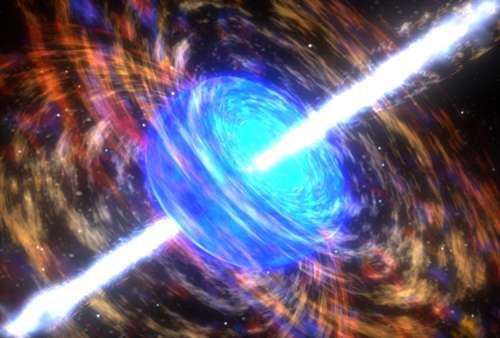Did a gamma ray burst accompany LIGO's gravity wave detection?

Last week's announcement that Gravitational Waves (GW) have been detected for the first time—as a result of the merger of two black holes—is huge news. But now a Gamma Ray Burst (GRB) originating from the same place, and that arrived at Earth 0.4 seconds after the GW, is making news. Isolated black holes aren't supposed to create GRB's; they need to be near a large amount of matter to do that.
NASA's Fermi telescope detected the GRB, coming from the same point as the GW, a mere 0.4 seconds after the waves arrived. Though we can't be absolutely certain that the two phenomena are from the same black hole merger, the Fermi team calculates the odds of that being a coincidence at only 0.0022%. That's a pretty solid correlation.
So what's going on here? To back up a little, let's look at what we thought was happening when LIGO detected gravitational waves.
Our understanding was that the two black holes orbited each other for a long time. As they did so, their massive gravity would have cleared the area around them of matter. By they time they finished circling each other and merged, they would have been isolated in space. But now that a GRB has been detected, we need some way to account for it. We need more matter to be present.
According to Abraham Loeb, of Harvard University, the missing piece of this puzzle is a massive star—itself the result of a binary star system combining into one—a few hundred times larger than the Sun, that spawned two black holes. A star this size would form a black hole when it exhausted its fuel and collapsed. But why would there be two black holes?
Again, according to Loeb, if the star was rotating at a high enough rate—just below its break up frequency—the star could actually form two collapsing cores in a dumbbell configuration, and hence two black holes. But now these two black holes would not be isolated in space, they would actually be inside a massive star. Or what was left of one. The remnants of the massive star is the missing matter.
When the black holes joined together, an outflow would be generated, which would produce the GRB. Or else the GRB came "from a jet originating out of the accretion disk of residual debris around the BH remnant," according to Loeb's paper. So why the 0.4 s delay? This is the time it took the GRB to cross the star, relative to the gravitational waves.
It sounds like a nice tidy explanation. But, as Loeb notes, there are some problems with it. The main question is, why was the GRB so weak, or dim? Loeb's paper says that "observed GRB may be just one spike in a longer and weaker transient below the GBM detection threshold."
But was the GRB really weak? Or was it even real? The European Space Agency has their own gamma ray detecting spacecraft, called Integral. Integral was not able to confirm the GRB signal, and according to this paper, the gamma ray signal was not real after all.
More information: Electromagnetic Counterparts to Black Hole Mergers Detected by LIGO. arxiv.org/abs/1602.04735
Source: Universe Today





















